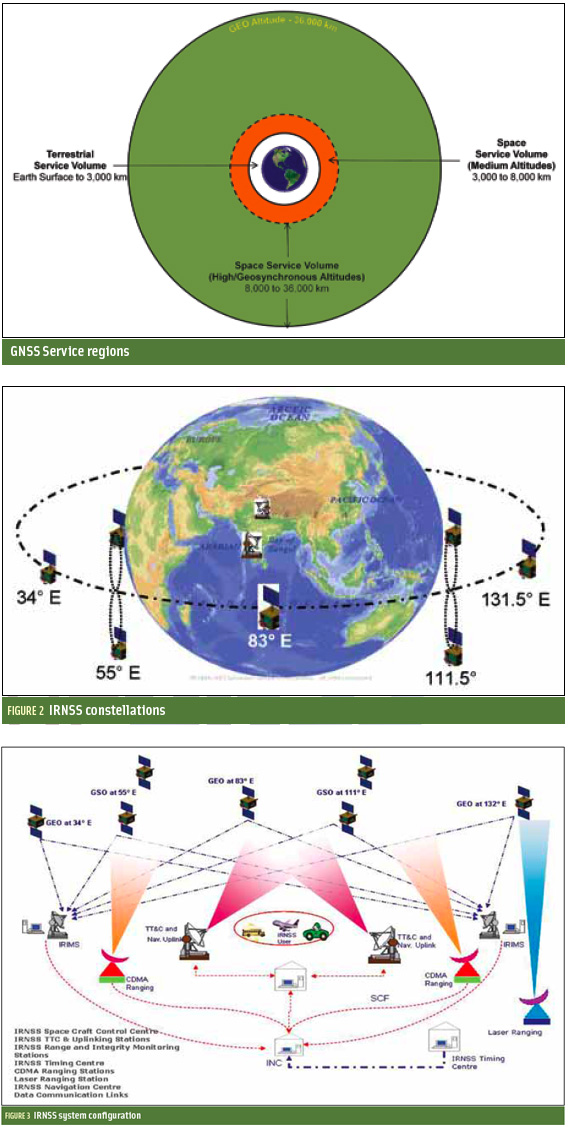Many navigation satellite systems have emerged since 2000.
GPS is the first global navigation satellite system (GNSS), followed by Russia’s GLONASS, reinvigorated in recent years. Europe is developing Galileo, and China is expanding the regional system Beidou to a global system called Compass (also referred to as Beidou-2).
Many navigation satellite systems have emerged since 2000.
GPS is the first global navigation satellite system (GNSS), followed by Russia’s GLONASS, reinvigorated in recent years. Europe is developing Galileo, and China is expanding the regional system Beidou to a global system called Compass (also referred to as Beidou-2).
Not all countries can afford to develop a GNSS, mostly because of the high cost, but also because they may not need global coverage. Several regional navigation satellite systems (RNSS) are under development, such as Japan’s QZSS, India’s IRNSS, and the first phase of Beidou (with completion of an east Asian coverage area currently projected for 2012).
A less well-known RNSS is the Chinese Area Positioning System, or CAPS. CAPS is a “passive” one-way system similar to most navigation satellite systems: satellites broadcast the navigation messages; receivers are only “listeners.” (Beidou-1 is a two-way system, the user also sends messages to the control center through satellites).
But CAPS is also different from all the other navigation satellite systems in that the navigation messages are generated on the ground and uploaded to the communication satellites, with the satellites acting only as transponders.
History and Basic Concepts
CAPS was initiated in 2002 based on a proposal from the National Astronomical Observatories of China (NAOC), Chinese Academy of Science (CAS).
The CAPS constellation consists of commercial geostationary (GEO) communication satellites and inclined geosynchronous orbit (IGSO) communication satellites. These spacecraft are not traditional navigation satellites: all the navigation-related facilities are all located on the ground.
This system has at least three major advantages:
- Operation does not require the launch of specific navigation satellites, but instead bandwidth can be rented on commercial communications satellites. Hence, the cost is much lower, and the deployment of the system can occur much more rapidly.
- Because all the navigation related facilities, especially the atomic clocks, are located in a ground station, the size of the clocks and their operational environment are no longer big issues. The system can use a larger but more accurate and reliable atomic clock (for the whole system rather than one clock for each satellite), and maintenance is obviously much easier.
- A receiver of this system by definition must also be able use the communications facilities of these satellites, meaning that versatile new applications can be considered for this system that are not inherent in other navigation satellite systems.
. . .
CAPS Signal Structure
In GEO communication satellite systems, C-band and Ku-band are popular for communications, while L band is rare. Because of the significant rain attenuation of Ku-band signals, C-band is the only suitable choice for a navigation satellite system.
Although most such systems use L-band, C-band has advantages and disadvantages for navigation: a C-band signal is less affected by ionospheric delay, less carrier phase noise, and better resistance of multipath. However, as with Ku-band, C-band has larger rain attenuation and larger tropospheric delay than L-band.
. . .
Virtual Atomic Clock
The standard time reference for CAPS is provided by the master clock — a hydrogen maser, which is located at the ground station. The master clock (UTC) of the National Time Service Center (NTSC) of China calibrates the CAPS clock. The time offset between the master clocks may be broadcast in the navigation messages.
Unlike GNSS systems, the CAPS satellites themselves do not carry atomic clocks. However, the pseudoranges used for positioning are the measurement between the satellite and the user; hence, the signal transmission time for that part of the signal path must be known. The actual range that is measured by the receiver is that from the ground station, which transmits the broadcast messages to the satellite, plus that from the satellite to the receiver.
. . .
SIGSO
If there are only GEO satellites in CAPS, the 3D position dilution of precision (PDOP) is poor, so that 3D positioning is impossible. This has led to the use of the receiver barometer in the early configuration of the system.
Two methods have been proposed to improve the CAPS PDOP. The first is to launch several IGSO satellites (at least three), which have “figure-8” ground tracks, as used by other systems such as IRNS and Japan’s Quasi-Zenith Satellite System (QZSS). (This approach also includes Compass, where three IGSO satellites are proposed). Use of IGSOs can decrease the PDOP significantly.
However, IGSO launches are not cheap; so, a second method was proposed — using retired GEO communication satellites by maneuvering them to so-called slightly inclined geostationary-satellite orbits (SIGSO).
GEO satellites are normally controlled to be “static” at their orbital slot, but many factors — such as gravitational effects of celestial bodies on the GEO —can change the orbits once control is relaxed. Consequently, GEO satellites always carry propellant fuel with which to maintain their orbital location — a technique referred to as station-keeping.
. . .
CAPS: Advantages and Disadvantages
As with any complex system in which numerous trade-offs must be analyzed to achieve an optimal solution, the Chinese Area Positioning System has both.
The advantages of the CAPS system design include the following:
1. CAPS is much cheaper than other navigation satellite systems, for two reasons: the system uses GEO communication satellites, especially retired ones and generates the navigation messages on the ground. Building a CAPS-like system that covered one-third of the Earth’s surface would only cost an estimated US$300 million — about one percent of the cost of a full-fledged GNSS.
2. The system can be deployed very quickly. All the important equipment in a traditional navigation satellite can be deployed on the ground. Only several more IGSO satellites are potentially needed in the constellation and those are basically communications satellites, which do not need a special design. To build the validation system only took three years.
3. Use by CAPS extends the lifetime of some communication satellites — in effect, “recycling in space.”
4. Because the CAPS spacecraft are communication satellites, they can be used not only for navigation but also for navigation-related communications or redeployed primarily for general communications at any time.
5. CAPS increases the number of navigation satellites visible in the Asia-Oceania area.
6. It has a similar signal structure to GPS (in a different band), making the development of an all-in-one receiver (for GPS, Galileo, Compass, QZSS, and so forth) easier, while making the equipment more robust against interference at any given radio frequency.
7. CAPS was developed for China, but a much larger Asian-Oceania area can benefit from it, especially South East Asia and part of Australia. Japan’s QZSS has already attracted much attention from some Asia-Oceania countries, including Australia. Because the CAPS constellation has more satellites and is a civilian system, it also has potential for international collaboration.
On the other hand, CAPS has a number of disadvantages:
1. C-band is used for the data link, making interoperability more complicated than for systems operating at L-band.
2. The system faces the possibility of same-frequency interference from other communication satellites. To solve this problem will require the collaboration of many organizations.
3. Because the satellite is only a transponder, the navigation signal relies on the ground station. If anything happens to the ground station or the uplink, the satellite loses its navigation function. Compared with the other navigation satellite systems, therefore, CAPS is more vulnerable.
4. A barometer may be needed to provide altitude. Local pressure and temperature data around China must be collected and broadcast by the satellites. If other countries want to use this system, this requirement is likely to become a problem. Other countries far from China would have to build their own ground station to generate the broadcast messages.
5. Generally, the PDOP of CAPS is not as good as that of GNSS systems, even if three IGSO satellites were launched.
6. Positioning, velocity, and time (PVT) accuracy is not as good as for GNSS systems. Based on the CAPS validation system (two GEO satellites located at 87.5°E and 110.5°E longitude, two SIGEOs located at 134°E and 142°E, plus a receiver barometer), the static PVT accuracies are as follows:
a. for standard service: position ~15–25 meters (1σ) horizontal, ~1–3m vertical; velocity, ~0.13~0.3 meters/second; time, 160 nanoseconds
b. for precision service: position ~5–10 meters (1σ) horizontal, ~1–3 meters vertical; velocity, ~0.15–0.17 meters/second;, time, 13 nanoseconds.
After the launch of IGSO satellites, the accuracy is expected to improve several times.
7. China has a working regional military satellite navigation system Beidou and it is on the way to expand this into a dual-use global system, Compass, which consists of five GEO satellites, three IGSO satellites, and 27 MEO satellites. Even those people who are working on CAPS agree that Compass will have priority, casting a shadow over the future of the CAPS.
Conclusion
Compass is a GPS-like system. The cost of this system will be tens of billions of dollars, and a debate is still underway in China about whether it is worth developing such a GNSS. The technical barriers, such as the on-board atomic clocks, are a great challenge for the development of Compass.
As a far cheaper alternative, CAPS has attracted many supporters. No matter what we argue about the good or bad elements of this system, it is very impressive to build a RNSS within three years. Where CAPS goes from here may not live up to this early success.
For the complete story, including figures, graphs, and images, please download the PDF of the article, above.
Additional Resources
[1] Ai, G., and H. Shi, H. Wu, Y. Yan, Y. Bian, Y. Hu, Z. Li, J. Guo, and X. Cai, “A Positioning System Based Satellite Communication and Chinese Area Positioning System (CAPS),” Chinese Journal of Astronomy and Astrophysics, 2008, 8(6), pp. 611-635
[2] Han, Y., and L. Ma, Q. Qiao, Z. Yin, and G. Ai, “Selection of Satellite Constellation Framework of CAPS. Science in China Series G: Physics, Mechanics & Astronomy, 2009, 52 (3), pp. 45-457
[3] Hu, Y., and Y. Hua, L. Hou, J. Wei, and J. Wu, Design and implementation of the CAPS receiver, Science in China Series G: Physics, Mechanics & Astronomy, 2009, 52 (3) pp 445-457
[4] Li, X., and H. Wu, Y. Bian, and D. Wang, “Satellite Virtual Atomic Clock with Pseudorange Difference Function,” Science in China Series G: Physics Mechanics & Astronomy, 2009, 52(3), pp. 353-359
[5] 卢晓春, 吴海涛, 边玉敬, 等. 中国区域定位系统信号体制. 中国科学G辑: 物理学 力学 天文学 (Science in China Series G: Physics, Mechanics & Astronomy), 2008, 38(12), pp. 1634—1647
[6] 韩延本, 马利华, 乔琪源, 尹志强, 施浒立, 艾国祥, 退役GEO 通信卫星对改善CAPS 系统 PDOP 的作用, 中国科学G辑: 物理学 力学 天文学 (Science in China Series G: Physics, Mechanics & Astronomy), 2008, 38(12), pp. 1738-1749






